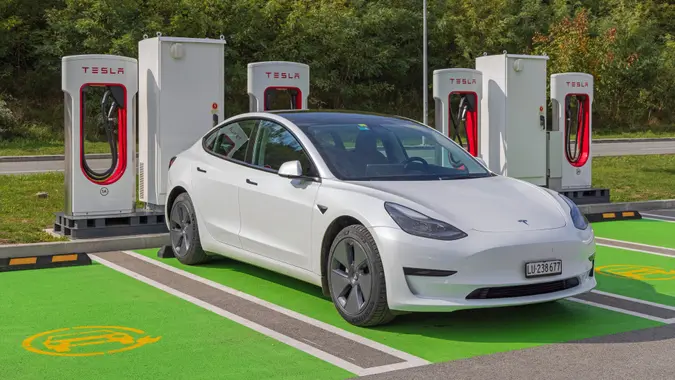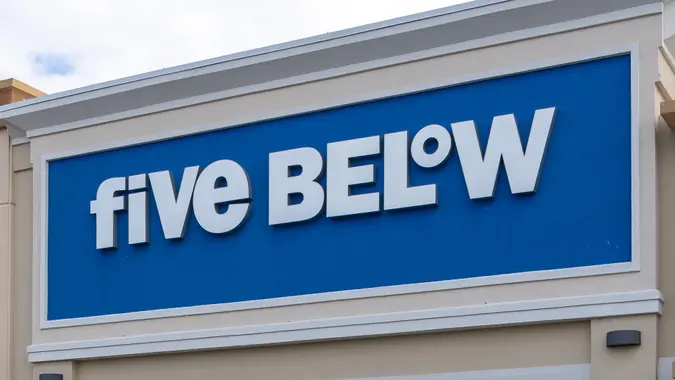Here’s How I Save Money by Grocery Shopping Just Once per Month

Commitment to Our Readers
GOBankingRates' editorial team is committed to bringing you unbiased reviews and information. We use data-driven methodologies to evaluate financial products and services - our reviews and ratings are not influenced by advertisers. You can read more about our editorial guidelines and our products and services review methodology.

20 Years
Helping You Live Richer

Reviewed
by Experts

Trusted by
Millions of Readers
Most people head to the supermarket weekly to restock their fridges. But grocery shopping can be a tedious, time-consuming chore, and all those small trips add up in time, money and energy spent. More trips means more time spent in store aisles and more opportunities for money-wasting impulse buys. Some shoppers have found a better way — doing just one major grocery trip per month instead of weekly runs.
Monthly grocery shopping requires more planning and organization upfront. But it ultimately saves money and reduces food waste. While it is an adjustment, the savings can make it worthwhile. Here’s how one expert does it and their tips for others looking to save on grocery shopping.
Devote Time to Meal Planning
Transitioning to monthly grocery shopping starts with upfront effort in meal planning. Before the big monthly shop, Stella Trainor devotes time to thinking through recipes for the coming weeks and mapping out a detailed grocery list.
“I used to go grocery shopping every week, but I realized I was wasting a lot of money that way,” said Trainor. “The impulse buys, extra items tossed in the cart and small purchases add up fast. So I decided to try doing all my grocery shopping for the month in one big trip. It forces me to really think about what I already have in the pantry and freezer, and to plan out recipes for the next four weeks.”
While it takes more time pre-grocery trip, this investment pays off later.
“It saves so much time compared to trying to decide what’s for dinner every night. I find myself throwing together meals more easily instead of defaulting to takeout on busy nights,” Trainor said.
Having a meal plan and grocery list in hand prevents those frustrating moments of staring at the shelves trying to figure out what you need. The time spent planning allows for quick, efficient shopping trips. Meal prep and list-making might seem like a chore, but it prevents headaches later and leads to better use of your budget.
Buy Meat, Frozen Items and Pantry Staples in Bulk
Buying meat, frozen items and shelf-stable pantry goods in large quantities can lead to big savings. Trainor utilizes her large freezer and pantry to stock up.
“I have a huge freezer, which enables me to buy meat and other frozen items in bulk,” said Trainor. “I break down big packages of chicken breasts, ground beef, etc., into meal-sized portions and freeze them in freezer bags for easy defrosting later. I save money buying larger packages, and there’s less waste since I freeze what I don’t use right away.”
Buying larger quantities usually costs less per unit, although you should check the pricing to make sure this is true on a case-by-case basis. Freezing in portions reduces waste since you can defrost only what you need for a recipe.
The same logic applies to pantry staples like grains, beans, canned goods and other nonperishables.
“Once a month I stock up on staples like rice, beans, oats, coffee, spices, canned goods — things that won’t go bad before I use them,” said Trainor. “Buying them in larger quantities saves money compared to buying them week-to-week.”
What About Fresh Produce?
While nonperishable items can be purchased in bulk for the month, fruits and vegetables require a little more planning.
“I plan the menu so I use up more perishable items like berries and bananas earlier in the month,” said Trainor. “There are lots of fruits and veggies with a long shelf life — apples, potatoes, onions, lemons, oranges, carrots and cabbage will all easily last a month if stored properly. And I always keep bags of frozen produce on hand too. Frozen fruits and veggies are just as nutritious as fresh.”
Trainor uses produce like berries, lettuce and tomatoes within the first week. Then she relies on longer-lasting fruits and vegetables like apples, carrots and cabbage, as well as frozen veggies to take her through week four.
When you shop every week, it’s easy to throw extra tomatoes, avocados or bagged salads into your cart without thinking through if you really need them. Then that produce can end up rotting in the fridge before you have a chance to use it. But if you buy only what you need for your meal plan, less spoilage means less wasted money.
More From GOBankingRates
 Written by
Written by  Edited by
Edited by 

























